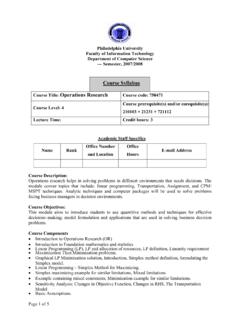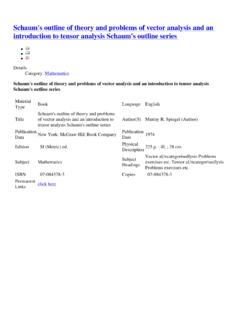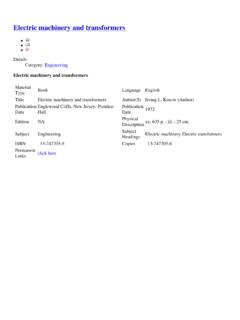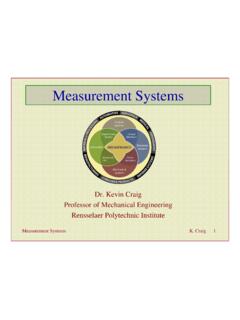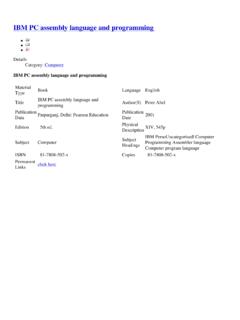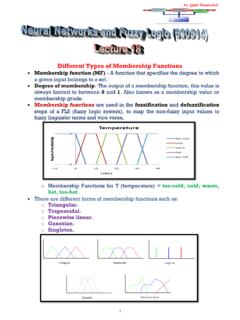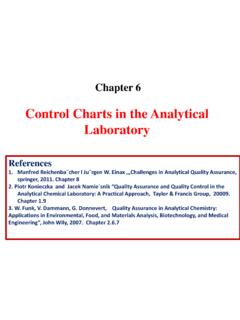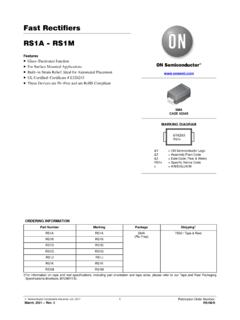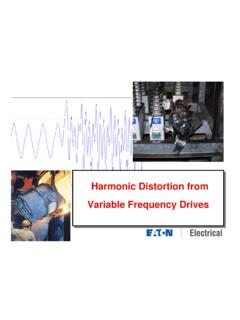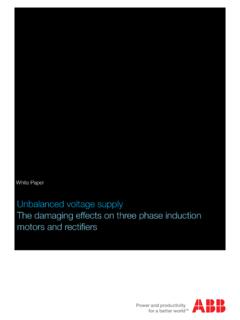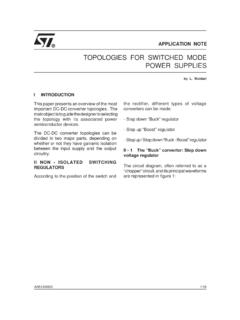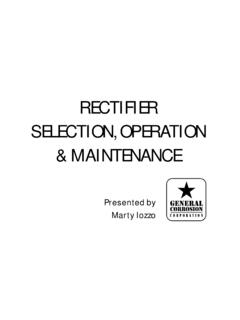Transcription of Single Phase Controlled Rectifiers - Philadelphia University
1 Power Electronics Single Phase Controlled Rectifiers 1 Dr. Firas Obeidat 2 Table of contents 1 Single Phase Controlled Half Wave rectifier - Resistive Load 2 Single Phase Controlled Half Wave rectifier - RL Load 3 Single Phase Full Wave rectifier - Resistive Load 4 Single Phase Full Wave rectifier - RL Load, Discontinuous Current 5 Single Phase Full Wave rectifier - RL Load, Continuous Current 6 Single Phase Full Wave rectifier - RL Load, L>>R 6 Single - Phase Bridge Half- Controlled rectifier Dr. Firas Obeidat Faculty of Engineering Philadelphia University 3 Dr. Firas Obeidat Faculty of Engineering Philadelphia University Single Phase Controlled Half Wave rectifier A way to control the output of a half-wave rectifier is to use an SCR1 instead of a diode. Two conditions must be met before the SCR can conduct: SCR must be forward-biased (vSCR > 0). current must be applied to the gate of the SCR. The SCR will not begin to conduct as soon as the source becomes positive.
2 Conduction is delayed until a gate current is applied, which is the basis for using the SCR as a means of control. Once the SCR is conducting, the gate current can be removed and the SCR remains on until the current goes to zero. Resistive Load 4 Dr. Firas Obeidat Faculty of Engineering Philadelphia University Single Phase Controlled Half Wave rectifier Resistive Load If a gate signal is applied to the SCR at t= , where is the delay (firing or triggering) angle. The average (dc) voltage across the load resistor and the average (dc) current are Vdc= The rms voltage across the resistor and the rms current are computed from The power absorbed by the resistor is = 2 = = 2 (1+ ) = = 2 1 ( + 2 2) = 21 ( + 2 2) 5 Dr. Firas Obeidat Faculty of Engineering Philadelphia University Single Phase Controlled Half Wave rectifier Resistive Load Example: The Single - Phase half wave rectifier has a purely resistive load of R and the delay angle is = /2, determine.
3 = 2 1+ 2= = 2 1+ 2= = 2 1 ( 2+sin (2 2)2)= = 21 ( 2+sin (2 2)2)= 6 Dr. Firas Obeidat Faculty of Engineering Philadelphia University Single Phase Controlled Half Wave rectifier Resistive Load Example: Design a circuit to produce an average voltage of 40V across a 100 load resistor from a 120 Vrms 60-Hz ac source. Determine the power absorbed by the resistance and the power factor. Vdc= so Vrms = = = = = , =120 7 Dr. Firas Obeidat Faculty of Engineering Philadelphia University Single Phase Controlled Half Wave rectifier RL Load The constant A is determined from the initial condition t= i( )=0: Substituting for A and simplifying, The extinction angle is defined as the angle at which the current returns to zero, as in the case of the uncontrolled rectifier . When t= The current is the sum of the forced and natural responses. 8 Dr. Firas Obeidat Faculty of Engineering Philadelphia University Single Phase Controlled Half Wave rectifier RL Load The above equation must be solved numerically for.
4 The angle ( - ) is called the conduction angle . The average (dc) output voltage is Vdc= The average (dc) output voltage is = = 2 ( ) or = The rms current is computed from Or it can be written as =12 ( )2 = 24 ( 12 2 +12 2 ) = = 2+( )2=1 2+( )2 24 ( 12 2 +12 2 ) 9 Dr. Firas Obeidat Faculty of Engineering Philadelphia University Single Phase Controlled Half Wave rectifier RL Load Example: For the circuit of Controlled half-wave rectifier with RL Load, the source is 120 Vrms at 60 Hz, R=20 , L= , and the delay angle is 45o. Determine (a) an expression for i( t), (b) the rms current, (c) the power absorbed by the load, and (d) the power factor. (a) (b) (c) (c) 10 Dr. Firas Obeidat Faculty of Engineering Philadelphia University Single Phase Controlled Full Wave rectifier The first figure shows a fully Controlled bridge rectifier , which uses four thyristors to control the average load voltage. Thyristors T1 and T2 must be fired simultaneously during the positive half wave of the source voltage vs to allow conduction of current.
5 To ensure simultaneous firing, thyristors T1 and T2 use the same firing signal. Alternatively, thyristors T3 and T4 must be fired simultaneously during the negative half wave of the source voltage. For the center-tapped transformer rectifier , T1 is forward-biased when vs is positive, and T2 is forward-biased when vs is negative, but each will not conduct until it receives a gate signal. The delay angle is the angle interval between the forward biasing of the SCR and the gate signal application. If the delay angle is zero, the Rectifiers behave exactly as uncontrolled Rectifiers with diodes. 11 Dr. Firas Obeidat Faculty of Engineering Philadelphia University Single Phase Controlled Full Wave rectifier Resistive Load The average component of the output voltage and current waveforms are determined from Vdc= = = (1+ ) =1 2 = 12 2 +sin (2 )4 = = 12 2 +sin (2 )4 The rms component of the output voltage and current waveforms are determined from The power delivered to the load is = 2 The rms current in the source is the same as the rms current in the load.
6 12 Dr. Firas Obeidat Faculty of Engineering Philadelphia University Single Phase Controlled Full Wave rectifier Resistive Load Example: The full-wave Controlled bridge rectifier has an ac input of 120 Vrms at 60 Hz and a 20 load resistor. The delay angle is 40o. Determine the average current in the load, the power absorbed by the load, and the source voltamperes. Vdc= = = The rms current in the source is also A, and the apparent power of the source is 13 Dr. Firas Obeidat Faculty of Engineering Philadelphia University Single Phase Controlled Full Wave rectifier RL Load, Discontinuous Current Load current for a Controlled full-wave rectifier with an RL load (fig. a) can be either continuous or discontinuous. For discontinuous current 1- at t=0 with zero load current, SCRs T1 and T2 in the bridge rectifier will be forward-biased and T3 and T4 will be reverse-biased as the source voltage becomes positive. 2- Gate signals are applied to T1 and T2 at t= , turning T1 and T2 on.
7 With T1 and T2 on, the load voltage is equal to the source voltage. The output current can be given as 14 Dr. Firas Obeidat Faculty of Engineering Philadelphia University Single Phase Controlled Full Wave rectifier RL Load, Discontinuous Current The above current function becomes zero at t= . If , the current remains at zero until t= + when gate signals are applied to T3 and T4 which are then forward-biased and begin to conduct. This mode of operation is called discontinuous current as shown in fig. b. Analysis of the Controlled full-wave rectifier operating in the discontinuous current mode is identical to that of the Controlled half-wave rectifier except that the period for the output current is rather than 2 rad. < + Discontinuous current 15 Dr. Firas Obeidat Faculty of Engineering Philadelphia University The average (dc) output voltage is The average (dc) output current is = = ( ) or = The rms voltage is computed from Or it can be written as =1 ( )2 = 22 ( 12 +12 ) = = 2+( )2=1 2+( )2 22 ( 12 +12 ) Single Phase Controlled Full Wave rectifier RL Load, Discontinuous Current =1 = ( ) The rms current is computed from 16 Dr.
8 Firas Obeidat Faculty of Engineering Philadelphia University Single Phase Controlled Full Wave rectifier RL Load, Discontinuous Current Example: A Controlled full-wave bridge rectifier has a source of 120 Vrms at 60Hz, R=10 , L=20mH, and =60o. Determine (a) an expression for load current, (b) the average load current, and (c) the power absorbed by the load. (a) (b) = = 10 60 216= = (c) =1 2+( )2 22 ( 12 +12 ) = ( 12 ( 216)+12 ( 60))= A = 2 = 10= W (d) 17 Dr. Firas Obeidat Faculty of Engineering Philadelphia University Single Phase Controlled Full Wave rectifier RL Load, Continuous Current If the load current is still positive at t= + when gate signals are applied to T3 and T4 in the above analysis, T3 and T4 are turned ON and T1 and T2 are forced OFF. The initial condition for current in the second half-cycle is not zero. In continuous current t= + . The current at t= + must be greater than zero for continuous-current operation.
9 Using 18 Dr. Firas Obeidat Faculty of Engineering Philadelphia University Single Phase Controlled Full Wave rectifier RL Load, Continuous Current Solving for Using Continuous current = =2 =1 + =2 The average (dc) output voltage and current are =1 ( )2 + = 2 = = 2+( )2= 2 2+( )2 The rms voltage and current are computed from 19 Dr. Firas Obeidat Faculty of Engineering Philadelphia University Single Phase Controlled Full Wave rectifier Highly Inductive Load, L>>R The behavior of the fully Controlled rectifier with resistive-inductive load (with highly inductive load) is shown in the figure. The high-load inductance generates a perfectly filtered current and the rectifier behaves like a current source. With continuous load current, thyristors T1 and T2 remain in the ON-state beyond the positive half-wave of the source voltage vs. For this reason, the load voltage can have a negative instantaneous value.
10 The firing of thyristors T3 and T4 has two effects: i)They turn off thyristors T1 and T2. ii)After the commutation they conduct the load current. 20 Dr. Firas Obeidat Faculty of Engineering Philadelphia University Single Phase Controlled Full Wave rectifier = =2 =1 + =2 The average (dc) output voltage and current are The rms voltage and current are computed from =1 ( )2 + = 2 = = Highly Inductive Load, L>>R Example: A Controlled full-wave bridge rectifier has a source of 120 Vrms at 60Hz, R=10 , L=100mH, and =60o. Determine (a) Verify that the load current is continuous. (b) the average load current, and (c) the power absorbed by the load. 21 Dr. Firas Obeidat Faculty of Engineering Philadelphia University Single - Phase Bridge Half- Controlled rectifier The rectifier shown in the figure consists of a combination of thyristors and diodes and used to eliminate any negative voltage occurrence at the load terminals.
